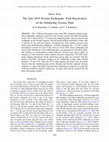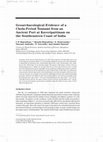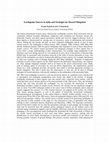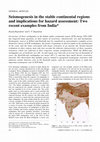Papers by Kusala Rajendran
Bulletin of the Seismological Society of America, Oct 1, 2011
Abstract The∼ 1300-km-long rupture zone of the 2004 Andaman–Sumatra megathrust earthquake continu... more Abstract The∼ 1300-km-long rupture zone of the 2004 Andaman–Sumatra megathrust earthquake continues to generate a mix of thrust, normal, and strike-slip faulting events. The 12 June 2010 M w 7.5 event on the subducting plate is the most recent large earthquake on the Nicobar segment. The left-lateral faulting mechanism of this event is unusual for the outer-rise region, considering the stress transfer processes that follow great underthrusting earthquakes. Another earthquake (M w 7.2) with a similar mechanism occurred very close ...

Geoarchaeology, Sep 29, 2011
Literature of the ancient Chola Dynasty (A.D. 9th–11th centuries) of South India and recent archa... more Literature of the ancient Chola Dynasty (A.D. 9th–11th centuries) of South India and recent archaeological excavations allude to a sea flood that crippled the ancient port at Kaveripattinam, a trading hub for Southeast Asia, and probably affected the entire South Indian coast, analogous to the 2004 Indian Ocean tsunami impact. We present sedimentary evidence from an archaeological site to validate the textual references to this early medieval event. A sandy layer showing bed forms representing high-energy conditions, possibly generated by a seaborne wave, was identified at the Kaveripattinam coast of Tamil Nadu, South India. Its sedimentary characteristics include hummocky cross-stratification, convolute lamination with heavy minerals, rip-up clasts, an erosional contact with the underlying mud bed, and a landward thinning geometry. Admixed with 1000-year-old Chola period artifacts, it provided an optically stimulated luminescence age of 1091 ± 66 yr and a thermoluminescence age of ...

The ∼1300-km-long rupture zone of the 2004 Andaman-Sumatra megathrust earthquake continues to gen... more The ∼1300-km-long rupture zone of the 2004 Andaman-Sumatra megathrust earthquake continues to generate a mix of thrust, normal, and strike-slip faulting events. The 12 June 2010 M w 7.5 event on the subducting plate is the most recent large earthquake on the Nicobar segment. The left-lateral faulting mechanism of this event is unusual for the outer-rise region, considering the stress transfer processes that follow great underthrusting earthquakes. Another earthquake (M w 7.2) with a similar mechanism occurred very close to this event on 24 July 2005. These earthquakes and most of their aftershocks on the subducting plate were generated by left-lateral strikeslip faulting on north-northeast-south-southwest oriented near-vertical faults, in response to north-northwest-south-southeast directed compression. Pre-2004 earthquake faulting mechanisms on the subducting oceanic plate are consistent with this pattern. Post-2004, left-lateral faulting on the subducting oceanic plate clusters between 5°N and 9°N, where the 90°E ridge impinges the trench axis. Our study observes that the subducting plate off the Sumatra and Nicobar segments behaves similarly to a chip of the India-Australia plate, deforming in response to a generally northwest-southeast oriented compression, an aspect that must be factored into the plate deformation models.
Current Science ( …, Jan 1, 2011
The 18 September 2011, magnitude Mw 6.9 earthquake close to the Nepal-Sikkim border caused signif... more The 18 September 2011, magnitude Mw 6.9 earthquake close to the Nepal-Sikkim border caused significant damage due to ground shaking and caused several landslides. Observations from the post-earthquake surveys in the affected areas within Sikkim suggest that the poorly engineered, multistoried structures were relatively more impacted. Those located on alluvial terraces were also affected. The morphology of the region is prone to landslides and the possibility for their increased intensity during the forthcoming monsoon need to be considered seriously. From the seismotectonic perspective, the mid-crustal focal depth of the North Sikkim earthquake reflects the ongoing deformation of the subducting Indian plate.
Engineering Geology, Jan 1, 1992
… on Interpreting the …, Jan 1, 1897

…, Jan 1, 2011
Literature of the ancient Chola Dynasty (A.D. 9th-11th centuries) of South India and recent archa... more Literature of the ancient Chola Dynasty (A.D. 9th-11th centuries) of South India and recent archaeological excavations allude to a sea flood that crippled the ancient port at Kaveripattinam, a trading hub for Southeast Asia, and probably affected the entire South Indian coast, analogous to the 2004 Indian Ocean tsunami impact. We present sedimentary evidence from an archaeological site to validate the textual references to this early medieval event. A sandy layer showing bed forms representing high-energy conditions, possibly generated by a seaborne wave was identified at the Kaveripattinam coast of Tamil Nadu, South India. Its sedimentary characteristics include hummocky cross-stratification, convolute lamination with heavy minerals, rip-up clasts, an erosional contact with the underlying mud bed, and a landward thinning geometry. Admixed with 1000-year-old Chola period artifacts, it provided an optically stimulated luminescence age of 1091 Ϯ 66 yr and a thermoluminescence age of 993 Ϯ 73 yr for the embedded pottery sherds. The dates of these proxies converge around 1000 yr B.P., correlative of an ancient tsunami reported from elsewhere along the Indian Ocean coasts. * Thermoluminescence (TL) procedures used in the analyses are after Aitken (1985). TL and optically stimulated luminescence (OSL) were measured with RisoTL/OSL (model TL DA-15) reader. The dose rate was determined on the basis of assaying Th, U, and K by XRF analyses of the bulk samples. Standard laboratory procedures were followed to extract quartz from the 90-125-mm size fraction. The extracted quartz grains were etched for 80 minutes in hydrofluoric acid (40%) to remove the 10-mm layer (the HF treatment also removes any feldspar contamination). The water content was determined for all the samples by heating at 100°C. TL/OSL ages back calculated from A.D. 2006. The single aliquot regeneration protocol was used for equivalent dose (ED) determination .
Journal of the Geological Society of India, Jan 1, 2009
Much has been written about the uniqueness of the planet Earth, its dynamic and precarious equili... more Much has been written about the uniqueness of the planet Earth, its dynamic and precarious equilibrium and about the processes that continue to shape its evolution. Global warming, overpopulation, and other critical environmental issues are pushing nations and citizens ...
Tectonophysics, Jan 1, 2011
Abstract The~ 2500 km-long Himalaya plate boundary experienced three great earthquakes during the... more Abstract The~ 2500 km-long Himalaya plate boundary experienced three great earthquakes during the past century, but none of them generated any surface rupture. The segments between the 1905–1934 and the 1897–1950 sources, known as the central and Assam seismic gaps respectively, have long been considered holding potential for future great earthquakes. This paper addresses two issues concerning earthquakes along the Himalaya plate boundary. One, the absence of surface rupture associated with the great ...

civil.iisc.ernet.in
The Indian subcontinent features many characteristic earthquakes sources: those associated with t... more The Indian subcontinent features many characteristic earthquakes sources: those associated with the continental collision boundary (Himalaya); subduction zone (Andaman and Nicobar); ancient rifts (Narmada, Kutch); non-rifted regions (peninsular shield) and reservoir triggered (Koyna). Each of these regions is characterized by varying rates of recurrence, styles of deformation and coseismic effects. During the last decade and half, we have witnessed earthquakes typical of each of these seismic sources. are typical earthquakes that originated in some of these characteristic seismic sources. The seismic hazard assessment and mitigation strategies in these regions have to evolve from a proper understanding of their characteristics. For example, large earthquakes in the Himalaya may recur during intervals of a few hundreds of years; those in the interior of the plate (like Killari) may be associated with recurrence intervals of the order of several thousands of years. The effects of the earthquakes can also be dramatically different in these regions. For example, liquefaction of soils was a primary cause of damage during the 2001 Bhuj earthquake. Response of engineered structures in each of these regions can also differ based on the attenuation characteristics, site response etc. Thus, damage mitigation strategies need to be based on the source characteristics (size, depth, style of faulting, nature of recurrence etc, and site effects (liquefaction, site amplification, ground failure etc.). Each earthquake provides site-specific data useful to develop appropriate strategies in hazard mitigation. This talk is about how the observations at each site can be used to develop strategies for hazard reduction, with specific emphasis on the earthquakes in the peninsular India.
Current Science ( …, Jan 1, 2011
Engineering Geology, Jan 1, 2006
… SOCIETY OF INDIA, Jan 1, 2004
Journal of the Geological Society of India. Vol: 64, No: 2, August 2004, pp: Mild Tremors near Th... more Journal of the Geological Society of India. Vol: 64, No: 2, August 2004, pp: Mild Tremors near Thalasseri (November, 2003): Evidence for a Seismic Source in North Kerala. KUSALA RAJENDRAN, CP RAJENDRAN and SREEKUMARI KESAVAN. Abstract: This note deals with the mild earth tremors that occurred near Thalasseri, Kannur District on November 8, 2003. Based on the activity detected by the broadband observatory at Peechi (PCH), we suggest an additional source zone in Kerala.
Bulletin of the Seismological Society of …, Jan 1, 2011
The 1300-km rupture of the 2004 interplate earthquake terminated at around 15° N, in the northern... more The 1300-km rupture of the 2004 interplate earthquake terminated at around 15° N, in the northernmost segment of the AndamanNicobar subduction zone. This part of the plate boundary is noted for its generally lower level seismicity, compared with the southern segments. Based on ...
Publikationsansicht. 5145593. Poroelastic models and the mechanism of reservoir induced seismicit... more Publikationsansicht. 5145593. Poroelastic models and the mechanism of reservoir induced seismicity / (1992). Rajendran, Kusala. Abstract. Typescript.. Thesis (Ph. D.)--University of South Carolina, 1992.. Includes bibliographical references (leaves 113-118). ...

CURRENT SCIENCE-BANGALORE-, Jan 1, 2003
Occurrence of three earthquakes in the Indian stable continental region (SCR) during 1993(SCR) du... more Occurrence of three earthquakes in the Indian stable continental region (SCR) during 1993(SCR) during -2001 has triggered many questions on their nature of recurrence, characteristic size and mechanisms. Seismogenic sources in Killari and Kachchh may be considered as representative examples of two distinctive classes of SCR earthquakes, the former originating on discrete faults in the unrifted part of the crust, and the latter associated with larger structures in an ancient rift. Seismic-hazard evaluation in these regions must take into account the inherent characteristics of these causative structures, which are reflected in their respective seismic productivities. While the Killari-type earthquakes are of moderate size (M ~ 6) and repeat over intervals of several tens of thousands of years, the Kachchh-type earthquakes are larger (M > 7), and may have much shorter recurrence intervals. The observation that multiple sources related to unexposed seismogenic structures with unknown seismic histories exist in the Kachchh region, calls for concerted efforts to study this important seismogenic zone in SCR India.










Uploads
Papers by Kusala Rajendran